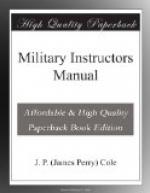done in broken detachments, which are far less distinct
than continuous column.
(c) Troops in a trench should crouch down in the shadowy side
and remain motionless.
(d) Faces should never be turned up, as the high lights on
cheek-bones and foreheads then show up distinctly.
(e) Bright metal on arms, equipment and headgear must be kept
covered.
2. Artillery wagon-trains, etc., should if possible be halted
promptly on warning. When halted, their neutral coloring
protects them.
3. Trenches are best concealed:
(a) By avoiding, in construction, a too regular outline, and
following as far as possible the contours of the ground.
(b) By coloring the parapet and parados to match the ground.
This may be done most quickly by painted canvas; if the
latter is not available, by planting or strewing the loose
earth with surrounding herbage. In this work care must be
taken not to make the covering itself too conspicuous by
brightness or monotony of coloring.
(c) By covering the trench itself, where convenient, with a thin
material, colored like the parapet and parados.
(d) By avoiding all overt movement of troops in the trenches
under observation.
4. Buildings, e.g., ammunition dumps, hangars, etc., can be
completely concealed by being painted the color of the
ground they stand on and fitted with canvas curtains,
similarly painted and stretched from the eaves to the
ground at a horizontal angle of 35 degrees. These curtains
completely eliminate shadows.
5. Success in each work of concealment by camouflage is best
assured by the assistance of an aeroplane observer to test
and correct it.
* * * * *
Orders Governing Intrenchment Problems at Second Plattsburg
Training
Camp.
HEADQUARTERS PLATTSBURG TRAINING CAMP,
PLATTSBURG BARRACKS, NEW YORK.
SEPTEMBER 22, 1917.
DIVISIONAL ENTRENCHING PROBLEM.
General Situation:
The Salmon river forms the boundary line between two states, the “Blue” on the north and the “Red” on the south. War has been declared and the Red Army is mobilizing near Keeseville. Mobilization by the first Blue Army at Plattsburg has been completed.
Special Situation, Blue:
Our advanced troops are holding the line of the Salmon river against strong detachments of the Red Army. The commanding general of the Blue Army has decided to establish a second position on the line, Bluff Point to the bend (248) in the Saranac river.
The following order is issued by the Division Commander:




